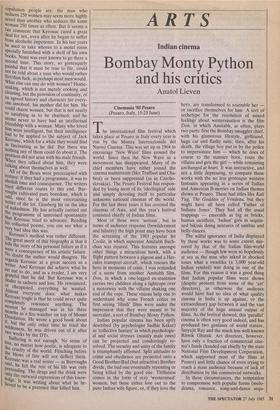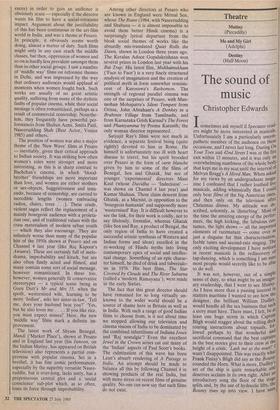ARTS
Indian cinema
Bombay Monty Python and his critics
Anatol Lieven
The international film festival which takes place at Pesaro in Italy every year is run by the Mostra Internazionale del Nuovo Cinema. This was set up in 1964 to encourage 'New Wave' films around the world. Since then the New Wave as a movement has disappeared. Many of its chief members have either joined the cinema mainstream (like Truffaut and Cha- brol) or been suppressed (as in Czecho- slovakia). The Pesaro Festival has respon- ded by losing most of its 'ideological' side and simply devoting itself to particular unknown national cinemas of the world. For the last three years it has covered the cinemas of Asia, and this year's festival consisted chiefly of Indian films.
Most of these were 'serious', but in terms of audience response (bewilderment and hilarity) the high point may have been the screening of the 1983 popular hit Coolie, in which superstar Amitabh Bach- chan was injured. This features amongst other things a miraculous hawk, with a flight pattern between a pigeon and a Her- cules transport-aircraft, which rescues the hero in moments of crisis. I was reminded of a scene from another Amitabh film, Don, in which a one-legged ex-stuntman carries two children along a tightrope over a motorway with the villains shaking one end of the rope. These visions help one to understand why some French critics on first seeing 'Hindi' films were under the impression that they were meant to be surrealist, a sort of Bombay Monty Python.
Indian popular cinema has been aptly described (by psychologist Sudhir Kakar) as 'collective fantasy' in which psychologic- al and social stresses (mainly male ones) can be projected and comfortingly re- solved. The security and unity of the family is triumphantly affirmed. Split attitudes to crime and obedience are projected onto a Good Brother/Bad (but attractive) Brother divide, the bad one eventually repenting or being killed by the good one. Titillation comes in the form of sexy 'westernised' women; but these either lose out to the pure Indian wife figure, or, if they love the hero, are transformed to resemble her — or sacrifice themselves for him. A sort of archetype for the resolution of mixed feelings about westernisation is the film Don, in which Amitabh, as often, plays two parts: first the Bombay smuggler chief, with his glamorous lifestyle, girlfriend, huge car and flashy suits; then, after his death, the village boy put in by the police to impersonate him — which he does of course to the manner born, routs the villains and gets the girl — while remaining unchanged at heart. It was instructive, and not a little depressing, to compare these works with the no less grotesque western fantasies appearing in a series of Italian and American B-movies on Indian themes shown at Pesaro. These had titles like Kali Yug, The Goddess of Vendetta, but they might have all been called 'Father of Indiana Jones'. They had all the usual trappings — emeralds as big as bricks, human sacrifices, 'Indian' girls in sequin- ned bikinis doing mixtures of sambas and belly-dances.
The wilful ignorance of India displayed by these works was to some extent mir- rored by that of the Italian film-world audience — though few were so hopelessly at sea as the man who asked in shocked tones what a swastika (a 3,000 year-old Indian symbol) was doing in one of the films. For this reason it was a good thing that Indian popular films were shown (despite protests from some of the 'art' directors), as otherwise the audience would have had no idea of what quality cinema in India is up against, or the extraordinary gap between it and the vast majority of the huge annual output of films. As the festival showed, this 'parallel' cinema is often very good indeed, and has produced two geniuses of world stature, Satyajit Ray and the much less well-known Ritwik Ghatak. Art directors, however, have only a fraction of commercial cine- ma's funds (handed out chiefly by the state National Film Development Corporation, which supported most of the films at Pesaro) and little chance of even trying to reach a mass audience because of lack of distribution by the commercial networks.
In these circumstances, the temptation to compromise with popular forms (melo- drama, romance, song-and-dance sequ- ences) in order to gain an audience is obviously acute — especially if the director wants his film to have a social-reformist impact. Argument about the justifiability of this has been continuous in the art-film world in India, and was a theme at Pesaro. In principle, it obviously seems worth doing, almost a matter of duty. Such films might only in any case reach the middle classes, but then, oppression of women and so on is hardly less prevalent amongst them than in other social groups. I saw a number of 'middle way' films on reformist themes in Delhi, and was impressed by the way that ordinary audiences would applaud at moments when women fought back. Such wo'rks are usually of no great artistic quality, suffering from many of the stylistic faults of popular cinema, while their social message is often romanticised, perhaps as a result of commercial censorship. Nonethe- less, they frequently have powerful per- formances from Shaban Azmi, Smita Patil, Naseerudding Shah (Best Actor, Venice 1985) and others.
The position of women was also a major theme of the 'New Wave' films at Pesaro — inevitably, given their critical approach to Indian society. It was striking how often women's roles were stronger and more interesting, as this is in sharp contrast to Bachchan's cinema, in which 'blood- brother' friendships are more important than love, and women are either mothers or sex-objects. Suggestiveness and innu- endo, because of censorship, are carried to incredible lengths (women embracing radios, chairs, trees . . .). These crude, violent sagas reflect the replacement of a mainly bourgeois audience with a proleta- rian one, and of traditional values with the crass materialism of modern urban youth — which they also encourage. They are infinitely worse than many of the popular hits of the 1950s shown at Pesaro and on Channel 4 last year (like Raj Kapoor's Awaara). These are certainly full of melo- drama, improbability and kitsch, but are also often finely acted and filmed, and many contain some sort of social message, however romanticised. In these too, however, women generally fit conservative stereotypes — a typical scene being in Guru Dutt's Mr and Mrs 55, when the spoilt, westernised wife, learning to be more 'Indian', asks her sister-in-law, 'Tell me, does your husband beat you?"Yes, but he also loves me. . . . If you like rice, you must expect stones!' Here, the new 'middle way' films mark a definite im- provement.
The latest work of Shyam Benegal, Mandi ('Market Place'), shown at Pesaro and in England last year (his Junoon, on the Indian Mutiny, has appeared on British television) also represents a partial com- promise with popular cinema. Set in a brothel, it has fine comic performances, especially by the superbly versatile Nasee- ruddin, but is over-long, lacks unity, has a preposterous central plot and a 'social conscience' sub-plot which, as so often, loses its force through improbability. Among other directors at Pesaro who are known in England were Mrinal Sen, whose The Ruins (1984, with Naseerudding and Shabana — it is almost impossible to avoid them better Hindi cinema) is a surprisingly lyrical departure from the bleak social themes of works like the absurdly mis-translated Quiet Rolls the Dawn, shown in London three years ago. The Keralan Adoor Gopalakrishnan won several prizes in London last year with his Rat Trap. His latest film, Mukhamukham ('Face to Face') is a very finely structured analysis of imagination and the creation of political myth in form somewhat reminis- cent of Kurosawa's Rashomon. The strength of regional parallel cinema was one of the surprises of Pesaro, with Man- mohan Mohapatra's Silent Tempest from Orissa, John Abraham's A Donkey in a Brahmin Village from Tamilnadu, and from Karnataka Grish Karnad's The Forest and Phaniyamma by Prema Karanth, the only woman director represented.
Satyajit Ray's films were not much in evidence, a separate festival being (quite rightly) devoted to him in Rome. He himself is unfortunately too ill with heart disease to travel, but his spirit brooded over Pesaro in the form of carte blanche given by him to some of the films of Benegal, Sen and Ghatak, but not of younger 'experimental' directors Mani Kaul (whose Duvidha — 'Indecision' — was shown on Channel 4 last year) and Kumar Shahani. These claim descent from Ghatak, as a Marxist, in opposition to the 'bourgeois humanist' and supposedly more 'westernised' Ray. It is difficult however to see the link, for their work is coldly, not to say lifelessly, formalist, whereas Ghatak (like Sen and Ray, a product of Bengal, the only region of India to have created a successful artistic synthesis of Western and Indian forms and ideas) excelled in the re-working of Hindu myths into living contemporary epics of social and intellec- tual change. Something of an epic charac- ter himself, he died of drink and tuberculo- sis in 1976. His best films, The Star Covered by Clouds and The River Subarna (called a 'modern Ramayana'), were made in the early Sixties.
The fact that this great director should have remained for so long virtually un- known to the wider world should be a source of shame here in Britain as well as in India. With such a range of good Indian films to choose from, is it not about time we stopped allowing our television and cinema visions of India to be dominated by the combined infantilisms of Indiana Jones and 'Raj nostalgia'? Even the excellent Jewel in the Crown series cut out many of the 'Indian' aspects of Paul Scott's books. The culmination of this wave has been Lean's absurb rendering of A Passage to India. An attempt should be made to balance all this by following Channel 4 in showing products of the real India, but with more stress on recent films of genuine quality. No one can now say that such films do not exist.















































 Previous page
Previous page